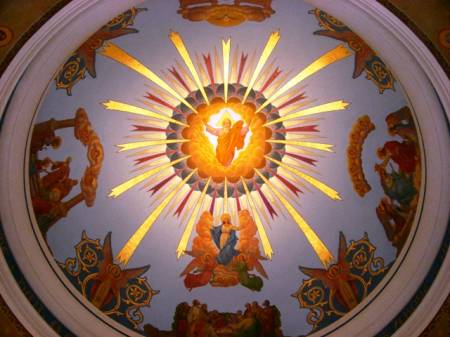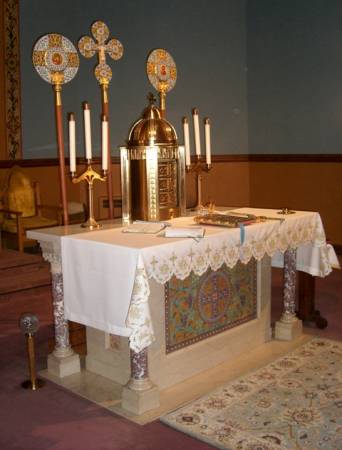By Joel Davidson
 Anchorage, Alaska, Feb 20, 2009 / 04:08 am (CNA).- Wide-eyed figures, often viewed as “windows to the eternal,” have long peered from rustic churches and chapels inside of Alaska’s Russian Orthodox churches. More recently, however, a growing number are appearing in local Catholic parishes as well.
Anchorage, Alaska, Feb 20, 2009 / 04:08 am (CNA).- Wide-eyed figures, often viewed as “windows to the eternal,” have long peered from rustic churches and chapels inside of Alaska’s Russian Orthodox churches. More recently, however, a growing number are appearing in local Catholic parishes as well.
These haloed, somber-looking forms are sacred icons, believed to be capable of reflecting the holiness of heaven into the earth, explains the Catholic Anchor.
A gift from the East
Dating back to the first centuries of Christianity, icons gained increased prominence in Alaska after Russian Orthodox missionaries landed on Kodiak Island in 1794. The images spread to churches and missions across the state and then on into the Western United States.
While long familiar to Orthodox and Byzantine Catholic traditions of the East, the increased presence of icons within Western Christianity, both Roman Catholic and Protestant, is part of what Deacon Charles Rohrbacher sees as a renewed interest in sacred art.
An internationally respected Catholic iconographer who now lives in the Diocese of Juneau, Deacon Rohrbacher has observed a growing fascination with icons in Western Christianity over the past quarter century.
“I often ask theologians and church leaders why there has been a resurgence in icons,” he said in a telephone interview with the Anchor. “They most commonly tell me that it is due to a deep hunger for transcendence.”
It is a hunger that Deacon Rohrbacher has seen cut across denominational lines as modern Christians seek deeper spiritual realities in an increasingly secular world. “The icon is a healing image,” he said. “So many modern images we see do not heal — they wound us. They are of terror and abuse. In the icon, Christ, Mary and the saints look on us in love and invite us to contemplation.”
Expanded use of icons
In Alaska, Deacon Rohrbacher’s icons hang from Catholic parishes in the Anchorage and Juneau dioceses, as well as in several Orthodox churches farther north.
One of his most prominent works, completed in 2003, is an icon screen, which includes 38 interlocking images that span the entire width of the sanctuary at St. Nicholas Byzantine Catholic Church in Anchorage. In traditional form, the screen depicts the salvation story through icon imagery.
Two of the largest Roman Catholic parishes in the Anchorage Archdiocese also have made recent moves to expand the place of icons within their communities. Most notably, a large four-by-six-foot icon of the Holy Family is under construction for prominent display in the sanctuary at Holy Family Cathedral in Anchorage.
Dominican Father Francis Hung Le, pastor of the cathedral, said he hopes the icon will bridge the wide cultural and linguistic diversity within the church and point the faithful to the transcendent truth reflected in the sacred image.
“We have so many languages at the cathedral but icons can speak a universal language,” he told the Anchor.
Rediscovering a Catholic tradition
Anchorage Archbishop Roger Schwietz sees the turn to icons as a positive development and one which might reconnect Catholics to part of their tradition which is often overlooked in the Western church.
“Icons are not new to us as Catholics,” he told the Anchor. “Icons were part of our church history in the first thousand years of Christianity before the split between Orthodox and Catholics.”
Several icons hang in Archbishop Schwietz’s private residence and prayer chapel in Anchorage. They are images which he said can “feed the spiritual life of prayer.”
“You don’t just look at icons, you pray with them, and we need to relearn that as Roman Catholics,” he said. “People find that sitting with an icon can help them focus and help them set aside the noise of this world.”
The Christian belief that heavenly realities can be experienced through physical forms and images dates back to the first centuries of the church. Theologically, icons are rooted in the understanding that God took on physical form through the incarnation of Christ. And while icons are not considered holy in their own right, they are believed to be sacred because of the spiritual realities which they reflect.
The icon is also linked closely to traditional Christian beliefs about the sacramental nature of the world, a world where bread and wine become the Body and Blood of Christ and where water becomes holy and spiritually transformative through baptism.
Beyond Catholic and Orthodox
Outside Catholic and Orthodox circles, icons are rarely seen in Christian churches. More commonly, though, they are found in private devotional practices.
Orthodox priest Father Mikel Bock sees this in his work as manager of the Russian Orthodox Museum in downtown Anchorage. There, he sells icons to Christians from various church backgrounds.
“It’s a combination,” he told the Anchor. “It is probably mostly Orthodox and Catholic, but an icon will sometimes strike someone and they will buy it because it affects them — it touches their heart.”
For those unfamiliar with icons, they serve as conversation starters, Father Bock added.
“People want to know the significance of them, who they are, what they mean,” he said.
Incarnate environments
In the years following the Second Vatican Council, Deacon Rohrbacher saw a number of Catholic parishes remove sacred art and statues from their sanctuaries in the 1970s and 80s.
“There was a tendency toward a kind of bare, stripped down minimalist church environment,” he said. “Many statues and pictures were shown the door but with nothing really to replace them.”
Deacon Rohrbacher remembers a moment in the 1970s, which inspired him to learn iconography. Walking into the new cathedral in San Francisco he was taken aback.
“It was very stark, very white and very, very bare,” he recalled. “Instinctively, it seemed that a Catholic Church without images of Christ and Mary and the saints was not fully proclaiming the Gospel,” he said. “It was a disincarnate environment.”
In more recent years, however, Deacon Rohrbacher thinks Vatican II has contributed to the reemergence of icons in some Catholic circles.
“Part of Vatican II was a return to original sources,” he explained. “That has been a part of the rediscovery of the role of the icon in the life of the church.”






